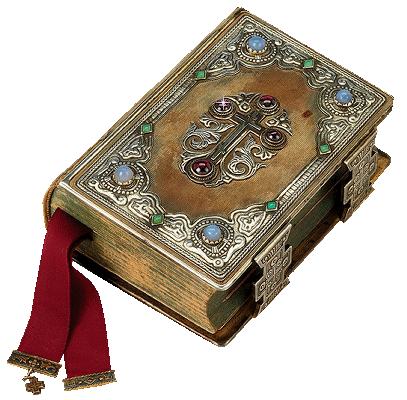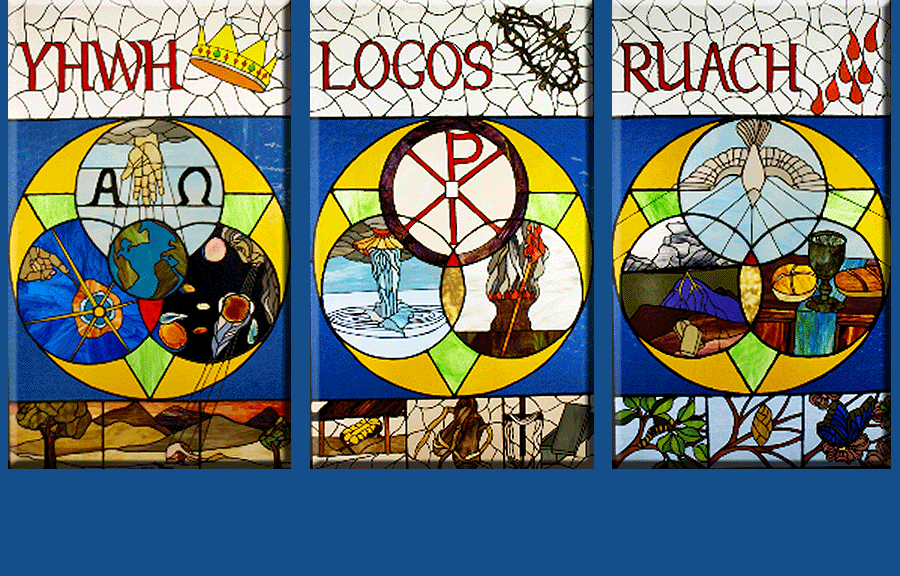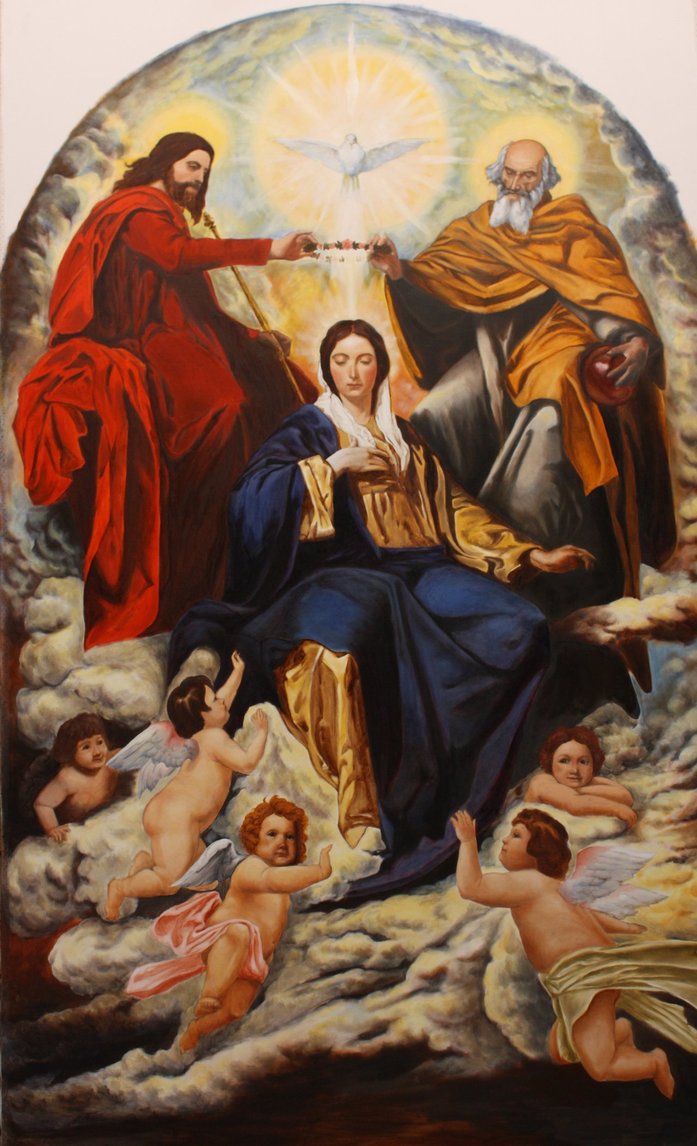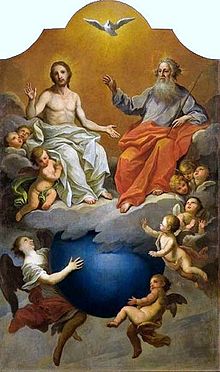|
|
Orthodox Outlet for Dogmatic Enquiries | Essays on Orthodoxy |
The depiction of the Holy Trinity
Source:
http://euxh.gr/theologia/katixitika/i-eikona-tis-agias-triados |
|
In Orthodox hagiography the Icon of the
Holy Trinity is depicted as “The Hospitality of Abraham”.
Hagiography is not any ordinary drawing; it is a
portrayal that contains theology.
The hagiographer expresses theology from
within the image.
So, let’s see what the hagiography of
“Abraham’s Hospitality” teaches us:
According to the narration of chapter 18 of the
Book of Genesis, Abraham – who was very hospitable to strangers – was
deemed worthy of offering his hospitality to the Triune God Himself.
The
Genesis
text
(18:1-5) says:
“Then
God appeared to him
(Abraham),
who was
seated at the door of his tent by the Mamre oak tree at noon. And, on
lifting his gaze, he looked, and behold, three men were standing further
up from him; seeing this, he immediately hurried towards them and
prostrated himself on the ground. And he said: ‘Lord, if I have found
favour in Your sight, do not come away from Your servant. Let water be
brought so that they may wash Your feet, and You may refresh Yourself
under the tree; I shall take bread and You shall eat, and afterwards You
can go on Your way, which You deviated from for Your servant’s sake.”
1) What were the signs that the three visitors were
God?
Well, Abraham ran towards them and prostrated
himself on the ground before them.
To
the Hebrews, prostration – especially full-body, on the ground – was
permitted only for God. Let’s also recall the incident with the Three
Young Men who were martyred in the blazing furnace for refusing to bow
down before king Nebuchadnezzar and his image. Obviously, full-body
prostration is evidence that the person being venerated can only be God.
Abraham
addressed one of the three visitors with the title “Lord”. In the Old
Testament, only Yahwe is the Lord God.
Therefore, Abraham was in a state of
theophany and “recognized” God in the person of one of the visitors.
2) The second question that is raised from within
the narration is:
Were those three men the three Persons of
the Holy Trinity?
Clearly, they were not.
The Triune God was only one of the three
visitors - the one portrayed in the middle, between the two other
persons in the icon. He was the one whom Abraham called “Lord”.
In the text the men are three, but Abraham
only addressed the one, whom he addressed as “Lord”.
Who were those three men? As we shall see revealed
further along (chapter 19) – in the narration regarding Sodom and
Gomorrah – the two of the three were angels. The third Person was the
pre-Incarnation Logos – the Second Person of the Holy Trinity. Why was
it the Logos?
Well, in the Holy Bible, the Prophets and
the Theumens (“God-sighters”) in the Old Testament and the Apostles in
the New Testament saw only the Logos:
in the Old Testament, the Logos was not yet
incarnate, whereas in the New Testament, He was seen incarnate - in the
flesh.
Yahwe-Melek / Angel of the Lord / Proclaimer of the
Supreme Will – as mentioned in the Holy Bible – is the
not-yet-incarnated Logos.
That was how the God-sighting Moses had
discoursed with Yahwe-Melek - the not-yet-incarnated Logos, the Son of
the Father - from within the blazing (but unconsumed by flames) bush.
But as we now know, from the revelation found in
the New Testament, both the Father and the Holy Spirit are “within the
Son”.
When Philip said to Christ: “Show
us the Father…”
Christ replied:
“I have
been with you for so long and yet you do not see Me, Philip? He who has
seen Me has seen the Father; so how can you say, ‘Show us the Father’?
Do you not believe that I am in
the Father, and the Father in Me?
” (John 14:9-10)
In other words, Christ was telling him that whoever
had seen Him had also seen the Father, because the Son is within the
Father, just as the Father is within the Son.
The Apostle Paul also wrote in his Epistle
to Colossians: “For
it pleased the Father that in Him bodily all the fullness of godhood
should dwell”.
(Col.1:19).
This means that the fullness of the Holy
Trinity resides in Christ.
This
was how the Theumens and Prophets of the Old Testament were able to
“see” the Father and the Holy Spirit within the pre-Incarnation Logos.
By having “seen” the pre-Incarnation, fleshless Logos, they were able to
comprehend the existence of the other two persons. This was how Abraham
was made worthy of offering hospitality to the entire Holy Trinity: in
the Person of the pre-Incarnation, fleshless Logos.
And that is why Orthodox hagiography portrays the Holy Trinity as “The
Hospitality of Abraham”.
But we – unfortunately in most churches (not to mention in practically
most of them) – have an icon of the Holy Trinity that portrays two men
and a bird….
As
such, the first mistake is that the three Persons of this Trinity are
not similar in appearance, given that two are humans and the one is a
bird and consequently, the Trinity depicted in this icon is not “of the
same essence” (homo-ousios).
Another mistake is that the Father is portrayed as an old, white-haired
man and the Son as a younger man with dark hair. This clearly implies
that the one is older than the other in age, which means created Time
has been “bestowed” on the Uncreated Holy Trinity. That is, we are
basically saying what the heretic Arius had asserted (and also what
Arius’ grandchildren – the Jehovah’s Witnesses still assert): that the
Son is a creation, since He is younger in years than the Father.
Yet another hagiographical mistake in the icon is
that the Father and the Holy Spirit are portrayed with a fleshy body.
Of course we know from the teaching of the
New Testament that only the Son had put on flesh with His Incarnation.
If the other two Persons of the Trinity are with flesh – as portrayed –
then we have a problem with the hypostatic characteristics – the
personal features – of the three Persons of the Holy Trinity.
The
Father begets the Son and issues forth the Holy Spirit.
ONLY
THE FATHER begets and issues forth.
The
Son is born.
ONLY
THE SON is born
And
the Holy Spirit issues forth.
ONLY
THE HOLY SPIRIT issues forth
That is why the Son was incarnated: because only He
has the hypostatic characteristic of being born.
If the other two Persons were to be
incarnated, then there would be a confusion within the Holy Trinity,
with various polytheistic extensions.
Therefore the only correct and appropriate theological depiction of the
Holy Trinity is the icon depicting Abraham’s Hospitality. *******************
Translation: A.N. |




